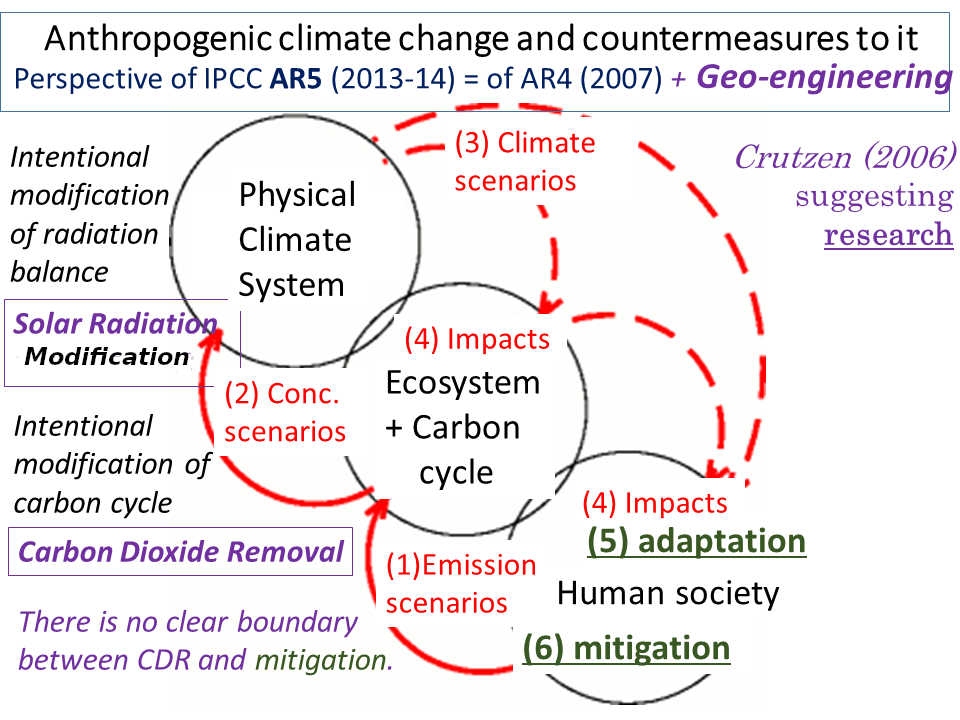climate change
Countermeasures to climate change
(A tentative page, to be reorganized)
Classification (which Masuda thinks reasonable)
- Adaptation
- Mitigation (mainly reduction of emission)
- Carbon capture and sequestration (CCS, considered as part of mitigation) + carbon dioxide removal from the atmosphere (CDR, considered as part of "geoengineering")
- Intervention to climate (mainly solar radiation modification, SRM) (part of "geoengineering")


Weight in discourses (subjective evaluation by Masuda)
| Adaptation | Mitigation | Carbon sequestration | Intervention (SRM) |
|---|
| US NRC 1983 | ++ | + | + | + |
|---|
| IPCC initial | + | +++ (not calles so yet) | | |
|---|
| IPCC 3rd, 4th | + [WG2] | +++ [WG3] | | |
|---|
| present | +++ [WG2] | +++ [WG3] | + (++ as future necessity) | + |
|---|
2019-June-27 Up to this point
Adaptation
- People has adapted to climate and to (natural) climate change.
- Adaptation to changing climate will become necessary.
In adaptation to climate itself, there is no need to separate natural and anthropogenic parts.
- When it is required to determine who should pay the cost,
responsibility of the "emitters" will be an issue.
(Share in emission is a matter of fact, and responsibility is a matter of norm.
They are different things. But they are considered to be related.)
- Traditionally, people often adapted by long-range migration.
- At present, long-range migration is difficult by social reasons
(national boundaries and land ownership).
It is considered that each nation should conduct adaptation policy,
with international collaboration as auxiliary help.
- In such cases where significant loss of habitable land is anticipated
(such as small flat island countries), international migration must be considered.
- Adaptation in agriculture ... (discussed in connection to impacts in agriculture)
- Adaptation in flood management (e.g. in Japan)
- Planning of construction (dams, levees, etc.) has been based on the idea that
statistical distribution of river flow remains constant.
In changing climate, its statistical distribution will also change.
- Probability of severe floods is likely to increase,
and construction to hold them may be too costly.
- Such "soft" ways as predition and evacuation seem more important.
- Stronger regulation of land use may also be necessary.
Mitigation
- Emission of carbon dioxide is deeply rooted in energy use in industrial civilization.
It is difficult to reduce it.
- cf. Preservation of stratospheric ozone ... chlorofluorocarbons ... producers are few, technology of replacement is possible.
- cf. Long-range transboundary air polution
- "I = P A T" thinking
- impact of human activity = population × "affluence" × "technology factor"
- More specialized form: "Kaya (Yoichi, 1997)'s identity":
- CO2 emission = population × GDP/population × (energy consumption)/GDP × (CO2 emission)/(energy consumption)
- Ways of reducing emission
- Reducing energy demands
- Improving efficiency of energy use (achieve the same effect with less energy consumption)
- Changing fossil fuel to other energy resourses
- Renewable energy
- Nuclear (Note: problem of radioactive wastes, risk of accidents)
- Choose relatively better fossil fuel (natural gas rather than coal)
- Policies to make social changes
- Ban and punishment
- Subsidies
- Taxes
- "Cap and trade"
- Anyway, "carbon pricing" is needed, as long as we live with market economy.
- Enhancement of CO2 sinks
- Helping growth of forests (afforestation, reforestation)
- Increase soil carbon storage
- Articifical carbon capture and sequestration ... costly, but necessary??
2019-July-11
MASUDA Kooiti


